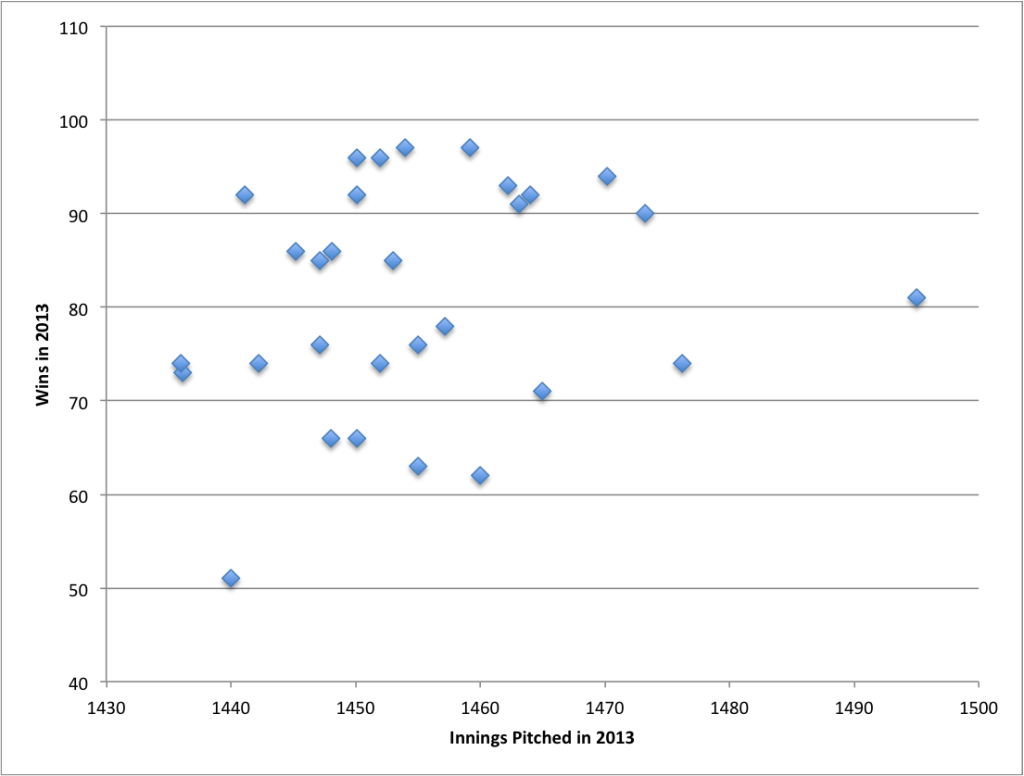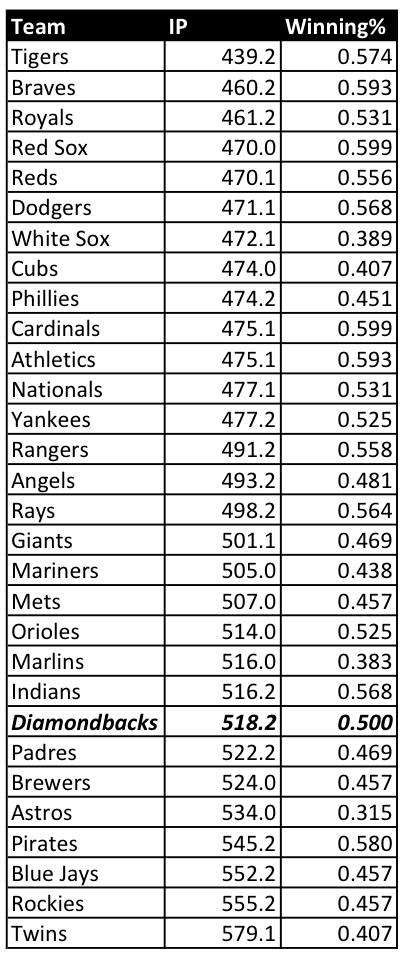Those damn extra innings
It’s no secret, the Diamondbacks played a ton of extra innings last year. It was brutal for the fan base to see blown saves or inept offense drive the team to extras time and time again. It led to some really exciting baseball on the one hand, but I can’t help but wonder what kind of toll it took on the team. Grinding out a 17-8 record in extra-inning games is pretty gritty, I guess, but it had to have come at a cost.
Arizona played the most innings in baseball last year, that’s a fact. It’s also a fact that they pitched 40 innings more than the average team in 2013, about 4.5 games worth. I love you, Josh Collmenter, but that discrepancy isn’t a good thing for the club. It’s also not good for my nerves and the rate of obscenities hurled at my television, but that’s neither here nor there.
It’s possible to pitch as few as 1377 innings in a 162-game schedule if you lost every road game in regulation and never went to extra innings at home, but the lowest number of innings pitched in 2013 was on the part of the Phillies at 1436. The Diamondbacks pitched a staggering 1495 innings, almost 60 more than Philadelphia. Of course, the Indians pitched very few innings (1441) and won 92 games, so innings pitched isn’t necessarily indicative of how good a team is.
In fact, take a look at the graph below to see where every team in baseball ranked in terms of wins and innings pitched in 2013:
*hint: that’s the Diamondbacks way out there on the right
There’s a big cluster in the middle with Arizona hanging out all alone on the fringe. Also, notice the shape of the cluster is in the rough shape of a triangle turned on its side, one that funnels down to the D-backs who serve as the pinnacle. It seems like the more innings a team pitches, the closer the team gets to 81 wins (.500). This can be observed in multi-year data, too, but the results get a little more sticky as teams’ winning percentages fluctuate year-to-year. I’ll spare you that graph.
Pitching so many innings means that you couldn’t finish off your opponent in regular frames. If I’m reading between the lines, that tells me that the the D-backs were good enough be in the game and very competitive but not good enough to overwhelm the the opposing team. Or, in other words, the definition of average. We’ve hashed out the averageness of the D-backs before many times, but this is a clear illustration of just how firmly they sat on the edge of mediocrity. Had they been a better (or worse) team, they wouldn’t have needed all of those extra innings.
There’s another question here to answer: who pitched all those extra innings? I mentioned my affinity for The Bearded Gargoyle above, but it was really a team effort on the mound from the bullpen. There isn’t a strong trend to starting pitcher usage as some poor teams actually got good mileage out of their crummy starters and good teams got a lot of innings out their horses, too. Let’s look at reliever innings, though:
As you can see, the teams that used their relievers the least often tended to be strong teams. We can think of some great bullpens out there (Boston and Atlanta come to mind immediately), but the truth is that bullpens are a necessary evil. You’d rather not have to use them if you can help it. Since it’s impossible to never use a reliever, you’d prefer to use them as sparingly as possible because the vast majority of relief pitchers just aren’t that good. As the saying goes, if the guys is that good of a pitcher, he’ll end up in the rotation. Most bullpens are comprised of rotation washouts that rely on their stuff playing up in shorter bursts out of the pen. So, in general, you’d rather allocate your innings to your best pitchers and not to your worst.
This is clearly not to say all relievers are bad pitchers. In fact, there are some really good ones out there. Luckily, Arizona has a handful of them. In 2013, however, their less-than-prime relievers were overexposed due to all the extra innings the team forced themselves into. No offense to Josh Collmenter, but I’d rather never see him pitch (unless Arizona’s up by a bunch of runs). Having to go to the ‘pen at an extreme rate is a sign that the team is not getting the job done in the first place.
The D-backs relief corps is as deep and talented as it’s been in recent memory, but everyone wears down under extreme workloads. The extra innings take their toll and most of that extra burden is placed on the relief staff. The knife cuts both ways as these situations also expose the relief staffs of Arizona’s opponents, but the team surely can’t afford another season in which it leads the league in extra innings.
It’s a bad sign all the way around.
3 Responses to Those damn extra innings
Leave a Reply Cancel reply
Recent Posts
@ryanpmorrison
 Congrats to @OutfieldGrass24 on a beautiful life, wedding and wife. He deserves all of it (they both do). And I cou… https://t.co/JzJtQ7TgdJ, Jul 23
Congrats to @OutfieldGrass24 on a beautiful life, wedding and wife. He deserves all of it (they both do). And I cou… https://t.co/JzJtQ7TgdJ, Jul 23 Best part of Peralta’s 108 mph fliner over the fence, IMHO: that he got that much leverage despite scooping it out… https://t.co/ivBrl76adF, Apr 08
Best part of Peralta’s 108 mph fliner over the fence, IMHO: that he got that much leverage despite scooping it out… https://t.co/ivBrl76adF, Apr 08 RT @OutfieldGrass24: If you're bored of watching Patrick Corbin get dudes out, you can check out my latest for @TheAthleticAZ. https://t.co/k1DymgY7zO, Apr 04
RT @OutfieldGrass24: If you're bored of watching Patrick Corbin get dudes out, you can check out my latest for @TheAthleticAZ. https://t.co/k1DymgY7zO, Apr 04 Of course, they may have overtaken the league lead for outs on the bases just now, also...
But in 2017, Arizona ha… https://t.co/38MBrr2D4b, Apr 04
Of course, they may have overtaken the league lead for outs on the bases just now, also...
But in 2017, Arizona ha… https://t.co/38MBrr2D4b, Apr 04 Prior to the games today, there had only been 5 steals of 3rd this season (and no CS) in the National League. The… https://t.co/gVVL84vPQ5, Apr 04
Prior to the games today, there had only been 5 steals of 3rd this season (and no CS) in the National League. The… https://t.co/gVVL84vPQ5, Apr 04
Powered by: Web Designers@outfieldgrass24
 Starting 2022 with a frigid dog walk sounds just lovely https://t.co/xoLZSZBpGp, 7 hours ago
Starting 2022 with a frigid dog walk sounds just lovely https://t.co/xoLZSZBpGp, 7 hours ago I’ll never forget seeing Kyle Seager at the Scottsdale Fashion Square one March with his family and thinking “damn,… https://t.co/uapNYdsU2a, Dec 30
I’ll never forget seeing Kyle Seager at the Scottsdale Fashion Square one March with his family and thinking “damn,… https://t.co/uapNYdsU2a, Dec 30 Big dogs. Bigger trees. @ Avenue of the Giants, Nor Cal https://t.co/YAdxcE1t1p, Dec 29
Big dogs. Bigger trees. @ Avenue of the Giants, Nor Cal https://t.co/YAdxcE1t1p, Dec 29 Old friend alert https://t.co/7HQjiyBWTB, Dec 27
Old friend alert https://t.co/7HQjiyBWTB, Dec 27 Death wish https://t.co/XJzcMkNPTy, Dec 26
Death wish https://t.co/XJzcMkNPTy, Dec 26
Powered by: Web Designers







Nice Post Jeff, the amount of extra innings games was a concern last season. It may have had an impact on our play later in the season as we quickly started to descend and eventually couldn’t catch up to LA.
As you mentioned before this is one of the better bullpen’s we have had in some time. Do you see us cracking the top 10 or 15 in reliever innings this season?
It would be great if our bullpen was used as sparingly as possible since that would generally indicate that we are winning consistently. That said, with several good options in the ‘pen, assuming JJ’s healthy and DHern is in good form, it will be tempting for Gibby to hook the starter.
Scoring more runs consistently is another part of this equation. The pitching is good enough to keep us competitive most nights, but more runs will mean more leads and more leads means more innings by starters and less by middle relievers.
Innings pitched by relievers is a indicator of several other components, so hopefully the team is solid and we don’t have to go to them as often as we did last season. More runs and fewer extra-inning games will help!
This is a fantastic article. It really did seem at the end of the season that the players were just simply fatigued. And of course, fatigued players aren’t always in the best of moods, so it would be only natural that having extra inning games would make the players a little more grumpy – the clubhouse as a whole would be annoyed to a point where it affects their game. The pitchers, of course, would feel like they let the team down a bit. Their brains may have a short memory, but their muscles at the end of a long season didn’t forget.
That being said, even with the pitching woes and sporadic offense, the defense was pretty solid. With Parra having the highest DRS in the outfield, Goldy having the most unassisted outs at 1B, and a very high defensive rating in the infield. The team wanted to win so badly, but they didn’t let the game come to them in areas where it counted the most.
We have some very good players and some new key coaches and staff to work with this year. The addition of Trumbo and Arroyo are going to make things even more exciting!